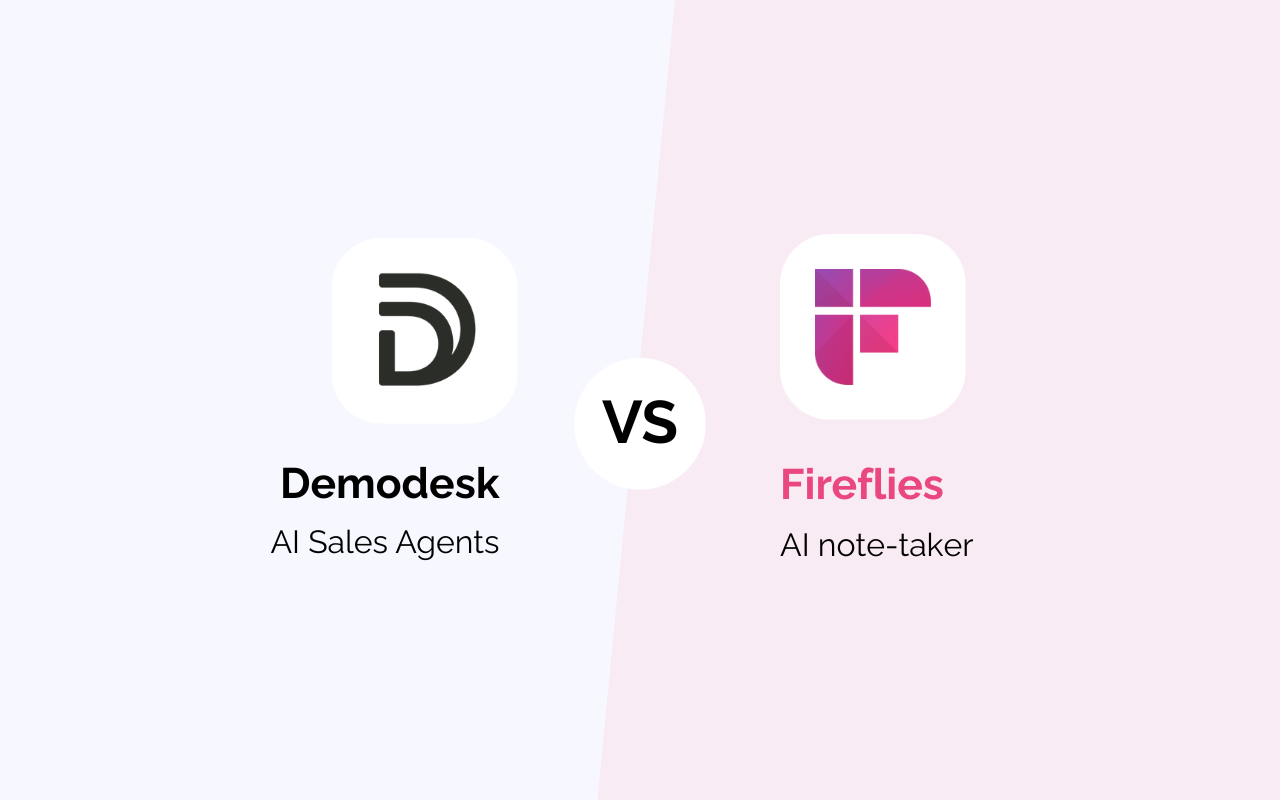How Great Sales Notes Lead to Winning Deals
People often take notes without giving it much thought. In sales, this can lead to missed details or a lack of understanding of what the customer actually wants. Many salespeople rush to close sales but don't capture the proper context for a call or meeting. They often rely on memory, but it fades quickly, leading to confusion later. Also, they lose valuable insights as a result.
Great sales come from attention to detail. When your notes accurately capture the buyer's intent, tone, and next steps, they can make it easier for you to identify what helped the buyer make a decision. Without proper notes, your CRM becomes unreliable and your data quality suffers, affecting everything from forecasting to coaching effectiveness.
In this blog, I'll help you learn how great notes can bring clarity, direction, and measurable results to your sales.
How Great Notes Lead to Great Sales
Every strong sale needs a fundamental understanding. It is not about chance. Notes help you follow what is key for every buyer. They make each talk a resource. You can look back at it later. This helps you better shape your next step. Clear notes let you spot buying signs. You can see the problems and the reasons they buy. These things are often lost during talk.
Accurate notes also help add a personal touch to every follow-up. When you recall details like "The client prefers product demos on Fridays" or "They're exploring competitors for better integration," it shows care and attention. This is a small but powerful way to gain trust and secure more deals.
Simply put, great notes help you recall what counts. They help you act on it too. This turns people who might buy into repeat customers.
Common Misconceptions About Sales Notes
Many sales teams misunderstand the importance of taking notes. Some think that recordings are enough. But recordings can only capture words, not meaning or intent. Real sales notes tell what matters and guide what should happen next. Still, many teams fail to capture notes correctly due to the following misconceptions:
1. Confusing Transcripts with Sales Notes
Call recordings or full meeting transcripts are not the same as sales notes. Transcripts are verbatim records, often lengthy and unstructured, capturing every word spoken. Sales notes, on the other hand, are concise, actionable summaries that highlight key points, decisions, and next steps. While transcripts might run dozens of pages, effective sales notes distill the most critical information into a format you can actually use.
2. Writing Notes Only for Managers
Notes are sometimes written to impress managers or for compliance, rather than to help the salesperson or customer move forward. This is a critical mistake. The best practice is to write notes as if you (or a teammate) will use them to follow up, ensuring clarity on next steps and customer context. Your future self should be able to pick up exactly where you left off.
3. Believing AI-Generated Notes Are Perfect
Many teams assume AI-generated notes are perfect and final. However, AI notes often need human review for accuracy, context, and nuance, especially for complex deals or subtle objections. A tool can list "price concern," but it cannot detect the hesitation in the buyer's tone or the unspoken worry behind their questions.
4. Thinking Recordings Replace the Need for Notes
Relying solely on recordings leads to missed insights, as few people re-listen to entire calls. Even when recordings are available, busy sales teams rarely have time to review hour-long conversations. Notes distill the most critical information, making it accessible and actionable in seconds rather than hours.
5. Not Realizing Poor Notes Skew Analytics
Incomplete or biased notes skew CRM analytics and coaching. Poor notes lead to insufficient data, which affects forecasting, coaching, and pipeline management. When your notes say "good call, follow up next week" without context, your CRM becomes unreliable for strategic decision-making.
Now, let's get to our main concern in the section below.
Creating Notes to Achieve Great Sales
The following are methods for creating detailed, organized notes that help increase sales.
Writing Notes That Support Action
What makes a sales note useful versus just a meeting recap? A useful sales note focuses on actionable items, customer pain points, commitments, objections, and next steps. A simple recap may just summarize what was discussed, lacking actionable insights or context for follow-up.
Sales notes should focus on the customer's objectives, outcomes, and next steps. They highlight factors that can affect the next steps in the sales process and help keep representatives prepared.
In SaaS and B2B sales, representatives usually use structured frameworks and templates to keep their notes clear. Popular frameworks include MEDDIC, BANT, and SPIN. For example, here's a template that top-performing teams use:
Customer Pain Points:
- Budget limits for Q4
- Integration concerns with the existing CRM
Solution Discussed:
- Phased implementation approach
- Custom API integration
Key Objections:
- Timeline concerns for implementation
- Need CFO approval for the budget
Decision Makers:
- Sarah (IT Director) - Primary champion
- Michael (CFO) - Final approver
Next Steps (with deadlines):
- Send product sheet by Friday
- Schedule demo with IT team - Tuesday 2 PM
- Prepare ROI analysis for CFO review
Follow-Up Date: Next Monday, 10 AM
Additional Context:
- Company expanding to three new markets in 2026
- Currently using a competitor product, but unhappy with support
This approach helps in keeping the notes concise and on point. It also ensures that every note supports sales progress rather than just documenting what happened. Also note that this process can be automated in Demodesk directly from your call transcript.
Structuring Notes for CRM and Handoffs
Structured notes help improve CRM (customer relationship management) and allow teams to work together seamlessly. Create clear categories in your notes, such as "Goals," "Challenges," and "Next Actions." Write in a structured pattern by including bullet points and short paragraphs. This makes it easy for teams to understand these notes.
When sales notes lack a clear structure, your teams might struggle to understand the intent. Staff may repeat conversations with the client, asking the same questions twice or missing critical context. This causes problems in how work gets done and damages your credibility with the customer. Well-structured notes help remove these common errors. They help everyone stay on track with customer needs.
The key to good handoffs is writing for someone who wasn't on the call. If you get sick, go on vacation, or a deal gets reassigned, another team member should be able to read your notes and continue the conversation without missing a beat. This means including:
- Clarity: Specific details, not vague summaries
- Linkage: References to related deals, contacts, and previous conversations
- Context: Why decisions were made, not just what was decided
When not using conversational intelligence, use a reliable note-taking tool that allows you to refine formatting. For example, writing in EditPad helps you take notes and improve messy formatting. It offers options to improve formatting, organize content into clear sections, and optimize your notes to transfer into a CRM system.
Well-structured notes save time, reduce mistakes, and make it easier for teams to close more deals.
AI and Human Collaboration in Modern Note-Taking
Modern teams are increasingly using AI in their note-taking, which reflects current best practices in AI-driven CRMs. AI tools help take notes and capture information quickly. At the same time, humans add insights, tone, and context. Together, they create notes that are way more useful.
Here's how top-performing teams divide the work between AI and humans:
AI Handles:
- Routine capture (names, dates, basic Q&A)
- Auto-filling standard fields
- Transcribing conversations
- Tagging actionable items and keywords
- Identifying mentioned competitors or objections
Humans Add:
- Nuance and strategic insights
- Emotional context and tone
- Unspoken concerns or hesitations
- Relationship dynamics between stakeholders
- Assessment of deal quality and likelihood to close
The Workflow:
- AI drafts initial notes during or immediately after the call
- Sales rep reviews and edits, adding context and personal observations
- Manager audits periodically for coaching opportunities
For example, AI tools like Otter.ai, Gong, or Demodesk can automatically transcribe meetings, tag actionable items, and highlight keywords. After this, the salesperson can review these and add the buyer's intent and emotional cues to them. AI tools can also summarize the information from the meetings. This combination of AI and human thoughts enhances customer interaction and ensures nothing critical falls through the cracks.
The key is completing this review immediately after the call while details are fresh. Waiting even a few hours can mean lost context and forgotten nuances.
Training Teams for Consistency
Note-taking should be consistent to generate reliable data for forecasting and coaching. For this, you need a uniform writing style. Like, if one member writes long sentences while the other uses fragments, the CRM becomes uneven. Training can fix it.
Many business teams conduct short workshops to teach their employees the importance of note-taking. They teach them some actionable tips to improve vague writing. Effective training programs include:
- Real Examples: Show both good and bad notes side by side
- Peer Reviews: Have team members review each other's notes
- Manager Feedback: Regular coaching on note quality
- Templates and Checklists: Provide clear frameworks everyone follows
- Scoring: Include note quality as part of performance reviews
For Example, instead of writing, "Client seemed unhappy," write it as "Client wants quick onboarding support - maximum 2-week timeline." The first sentence can be categorized as bad notes, as it leads to poor coaching and missed opportunities. Whereas the second sentence is clear, specific, and actionable.
Here's how bad notes create downstream issues:
Bad Note Example: "Good call, follow up next week."
Problems This Creates:
- No context for why the call was good
- Unclear who should follow up on what
- No customer pain points captured
- Impossible to forecast deal progression
- New team member couldn't continue the conversation
- Manager can't provide meaningful coaching
Better Note Example: "Strong call - client confirmed budget approved for Q1. Main concern is implementation timeline (wants < 30 days). Next step: I'll send a case study showing 3-week implementation, then schedule a technical review with their IT lead, Maria by Friday."
When the team notes align, they can better share the client concerns. When concerns are addressed, it leads to repeat sales. Always edit notes and improve clarity right after the call when the details are easy to recall.
How Sales Organizations Use Notes for Coaching and Forecasting
Modern sales organizations don't just use notes for individual follow-ups—they leverage them for broader strategic purposes:
For Coaching:
- Managers score calls based on note quality and completeness
- Notes reveal patterns in how reps handle objections
- Automated reminders trigger based on action items in notes
- Best practices are identified and shared across the team
For Forecasting:
- Action items and deal stages from notes feed into pipeline analytics
- Standardized notes enable accurate probability assessments
- Historical notes help predict which deals will close
For Sales Enablement:
- AI notes populate enablement platforms automatically
- Content gaps are identified based on recurring questions in notes
- Playbooks are built from successful conversation patterns
- Notes feed into continuous improvement for onboarding
This is why note quality matters far beyond just one deal. Your notes become institutional knowledge that makes your entire organization more innovative and more effective.
GDPR and Privacy in Note-Taking
Data privacy matters when the notes are written and stored. It is common in sales teams to use AI tools that gather personal data. Under GDPR and other privacy regulations, every note must comply with consent and privacy rules. So, you should only record or write information that the customer agrees to share and avoid adding personal or sensitive details that are not relevant to the sale.
Current best practices for GDPR-compliant note-taking include:
- Avoid PII Unless Necessary: Don't capture personal identification information that isn't needed for the sales process
- Anonymize Sensitive Data: Remove or mask information that could identify individuals in ways not relevant to the deal
- Get Consent for Recordings: Always inform participants that calls are being recorded and get explicit consent
- Use Secure, Compliant Platforms: Choose CRM and note-taking tools with proper security certifications
- Implement Automated Redaction: Use tools that automatically remove sensitive information
- Enable User-Controlled Data Retention: Allow customers to request deletion of their data
- Maintain Audit Trails: Keep records of who accessed notes and when
Most of the sales notes apps have built-in privacy settings, such as data redaction and limited access. It is essential to review their CRM compliance options daily. Many modern platforms offer automated compliance features that flag potential privacy issues in notes before they're saved to your CRM.
Trends in this space include more sophisticated AI that can automatically identify and protect sensitive information, giving customers greater control over their data and creating clear audit trails for regulatory compliance.
Quick Reference: Good vs. Bad Sales Notes
To help you immediately improve your note-taking, here's a comparison of what works and what doesn't:
Use this table as a checklist after every call. If your notes don't meet the "Good" criteria, take two minutes to improve them before moving on.
Conclusion
Some people might take notes as meeting transcripts. They don't care much about it because they think everything is being recorded. However, many successful deals depend upon accurate and thoughtful notes.
Great sales notes are not just about documenting what happened—they're about enabling what happens next. They transform conversations into actionable intelligence, individual knowledge into team assets, and good intentions into closed deals.
Innovative tools can improve the note-taking process. They can assist the human effort, and this combined approach leads to improved sales. The AI handles the mechanical work of capturing information, while humans provide the strategic context and emotional intelligence that machines can't replicate.
Overall, great sales notes don't just describe what happened, but tell what should happen next. They create clarity where there was confusion, direction where there was uncertainty, and results where there were only possibilities. Master your note-taking, and you'll master your sales process.
Start today: Review your last five sales calls. Do your notes pass the test? Would a teammate be able to continue those conversations without you? If not, use the frameworks and templates in this article to level up your practice. Your future self—and your sales numbers—will thank you.











